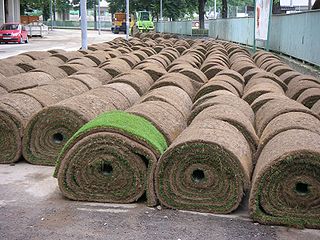
Sod, also known as turf, is the upper layer of soil with the grass growing on it that is often harvested into rolls.
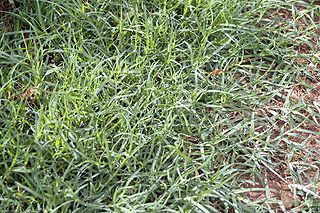
Cynodon dactylon, commonly known as Bermuda grass, is a grass found worldwide. It is native to Europe, Africa, Australia and much of Asia. It has been introduced to the Americas. Contrary to its common name, it is not native to Bermuda and is in fact an abundant invasive species there. In Bermuda it has been known as "crab grass". Other names are Dhoob, dūrvā grass, ethana grass, dubo, dog grass, dog's tooth grass, Bahama grass, crab grass, devil's grass, couch grass, Indian doab, arugampul, grama, wiregrass and scutch grass.

Paspalum is a genus of plants in the grass family.

Paspalum notatum, known commonly as bahiagrass, common bahia, and Pensacola bahia, is a tropical to subtropical perennial grass. It is known for its prominent V-shaped inflorescence consisting of two spike-like racemes containing multiple tiny spikelets, each about 2.8–3.5 millimetres (0.11–0.14 in) long.

Agrostis stolonifera is a perennial grass species in the family Poaceae.
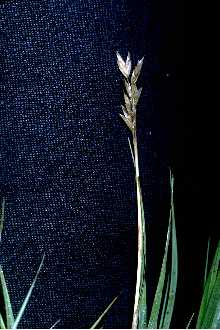
Distichlis spicata is a species of grass known by several common names, including seashore saltgrass, inland saltgrass, and desert saltgrass. This grass is native to the Americas, where it is widespread. It can be found on other continents as well, where it is naturalized. It is extremely salt tolerant.

St. Augustine grass, also known as buffalo turf in Australia and buffalo grass in South Africa, is a species of grass in the family Poaceae. It is a warm-season lawn grass that is popular for cultivation in tropical and subtropical regions. It is a medium- to high-maintenance grass that forms a thick, carpetlike sod, crowding out most weeds and other grasses.

The tropical grass species Cenchrus clandestinus is known by several common names, most often Kikuyu grass, as it is native to the highland regions of East Africa that is home to the Kikuyu people. Because of its rapid growth and aggressive nature, it is categorised as a noxious weed in some regions. However, it is also a popular garden lawn species in Australia, New Zealand, South Africa and the southern region of California in the United States, as it is inexpensive and moderately drought-tolerant. In addition, it is useful as pasture for livestock grazing and serves as a food source for many avian species, including the long-tailed widowbird. The flowering culms are very short and "hidden" amongst the leaves, giving this species its specific epithet (clandestinus).

Paspalum scrobiculatum, commonly called Kodo millet or Koda millet, is an annual grain that is grown primarily in Nepal and also in India, Philippines, Indonesia, Vietnam, Thailand, and in West Africa from where it originated. It is grown as a minor crop in most of these areas, with the exception of the Deccan plateau in India where it is grown as a major food source. It is a very hardy crop that is drought tolerant and can survive on marginal soils where other crops may not survive, and can supply 450–900 kg of grain per hectare. Kodo millet has large potential to provide nourishing food to subsistence farmers in Africa and elsewhere.
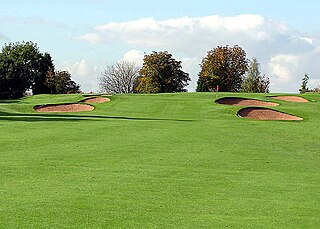
Golf course turf is the grass covering golf courses, which is used as a playing surface in the sport of golf. The grass is carefully maintained by a greenskeeper to control weeds, insects and to introduce nutrients such as nitrogen fertilization. The grass is kept at a constant height by mowing.
Dollar spot is a fungal disease of turfgrass caused by the four species in the genus Clarireedia, in the family Rutstroemiaceae. The pathogen blights leaf tissues but does not affect turf grass roots or crowns. There is evidence that a fungal mycotoxin produced by the pathogen may cause root damage, including necrosis of the apical meristem in creeping bentgrass. However, the importance of this toxin is unknown and its effects are not considered a direct symptom of dollar spot. The disease is a common concern on golf courses on intensely managed putting greens, fairways and bowling greens. It is also common on less rigorously maintained lawns and recreational fields. Disease symptoms commonly result in poor turf quality and appearance. The disease occurs from late spring through late fall, but is most active under conditions of high humidity and warm daytime temperatures 59–86 °F (15–30 °C) and cool nights in the spring, early summer and fall. The disease infects by producing a mycelium, which can be spread mechanically from one area to another.
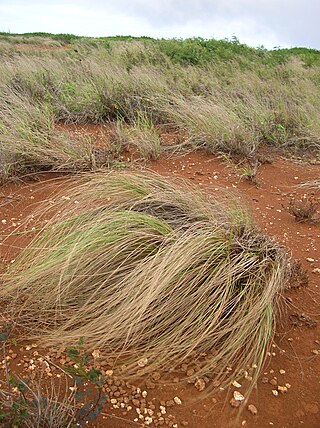
Eragrostis curvula is a species of grass known by the common name weeping lovegrass. Other common names include Boer lovegrass, curved lovegrass, Catalina lovegrass, and African lovegrass.

Panicum repens is a species of grass known by many common names, including torpedo grass, creeping panic, panic rampant, couch panicum, wainaku grass, quack grass, dog-tooth grass, and bullet grass. Its exact native range is obscure. Sources suggest that the grass is native to "Africa and/or Asia", "Europe or Australia", "Eurasia", "Australia", "Europe, Asia, and Africa", or other specific regions, including the Mediterranean, Israel, and Argentina. It is present in many places as an introduced species and often a noxious weed. It has been called "one of the world's worst weeds."

Paspalum plicatulum is a species of grass known by the common name brownseed paspalum. In Brazil its names include capim coquerinho, felpudo and pasto-negro. It is called zong zi que bai in Chinese and herbe à cheval in French. In South America its names include camalote, gamelotillo, and hierba de cepa. It is native to the Americas, where it occurs in the southeastern United States, Mexico, the Caribbean, and parts of South America.

Paspalum setaceum is a species of grass known by several common names, including thin paspalum. It is native to the Americas, where it can be found in the eastern and central United States, Ontario in Canada, Mexico, Central America, and the Caribbean. It can be found in other areas of the world as an introduced, and often invasive, species, including many Pacific Islands. It is a weed of lawns and turf.
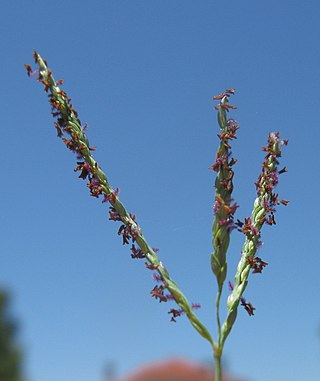
Digitaria didactyla is a species of grass known by the common names blue couch, Queensland blue couch, blue serangoon grass, green serangoon grass, blue stargrass, and petit gazon. It is native to Mauritius, Réunion, parts of mainland Africa, and Madagascar. It has been introduced widely outside its native range, mainly for use as a pasture and turf grass. It has naturalized in some regions.
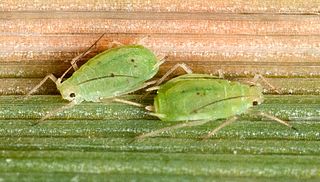
The greenbug, or wheat aphid, is an aphid in the superfamily Aphidoidea in the order Hemiptera. It is a true bug and feeds on the leaves of Gramineae (grass) family members.

Brachiaria mutica is a species of grass known by the common names para grass, buffalo grass, Mauritius signal grass, pasto pare, malojilla, gramalote, parana, Carib grass, and Scotch grass. Despite its common name California grass, it does not occur in California; it is native to northern and central Africa and parts of the Middle East, where it is cultivated for fodder. It was introduced elsewhere and it is now cultivated throughout tropical regions of the world for this purpose.

Zoysia japonica is a species of creeping, mat-forming, short perennial grass that grows by both rhizomes and stolons. It is native to the coastal grasslands of southeast Asia and Indonesia. The United States was first introduced to Z. japonica in 1895. It received its first import from the Chinese region of Manchuria. Today, Z. japonica has become one of the most widely used species of turfgrass in the United States and other countries worldwide such as in Brazil, serving as a close and cheaper alternative to bermudagrass.

Paspalum conjugatum, commonly known as carabao grass or hilo grass, is a tropical to subtropical perennial grass. It is originally from the American tropics, but has been naturalized widely in tropical Southeast Asia and Pacific Islands. It has also spread to Northern Africa and Northern and Eastern Australia. It is also known as sour paspalum, T-grass, or more confusingly, as "buffalo grass" or "sour grass".




















